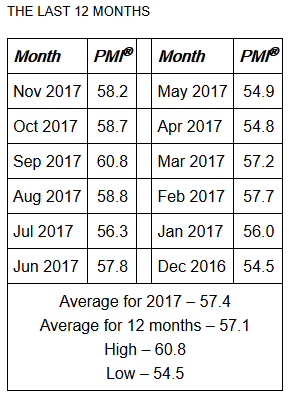The
Consumer Confidence Index® (CCI) for this month (December 2017) was
released by
The Conference Board® this morning:
Predicted: 128.0
Actual: 122.1
================
Previous month, revised:
128.6
================
The "predicted" figure is what economists were expecting, while the "actual" is the true or real figure.
From Today's Report:
"...'Consumer confidence retreated in December after reaching a 17-year high in November,' said Lynn Franco, Director of Economic Indicators at The Conference Board. 'The decline in confidence was fueled by a somewhat less optimistic outlook for business and job prospects in the coming months. Consumers’ assessment of current conditions, however, improved moderately. Despite the decline in confidence, consumers’ expectations remain at historically strong levels, suggesting economic growth will continue well into 2018.'
Consumers’ appraisal of present-day conditions was slightly more positive in December. The percentage saying business conditions are 'good' increased marginally from 35.0 percent to 35.2 percent, while those saying business conditions are 'bad' decreased marginally, from 12.3 percent to 12.1 percent. Consumers’ assessment of the labor market was mixed. Those claiming jobs are 'plentiful' decreased from 37.5 percent to 35.7 percent, while those claiming jobs are 'hard to get' also decreased, from 16.8 percent to 15.2 percent (a 16-year low).
Consumers’ optimism about the short-term outlook declined sharply in December. The percentage of consumers anticipating business conditions to improve over the next six months declined from 23.1 percent to 20.2 percent, while those expecting business conditions to worsen increased from 6.7 percent to 9.2 percent.
Consumers’ outlook for the job market was also less upbeat than in November. The proportion expecting more jobs in the months ahead decreased from 21.3 percent to 18.4 percent, while those anticipating fewer jobs rose from 12.1 percent to 16.3 percent. Regarding their short-term income prospects, the percentage of consumers expecting an improvement increased from 20.3 percent to 22.3 percent, while the proportion expecting a decrease also rose, from 7.6 percent to 8.9 percent..."
Every month, The Conference Board sends a questionnaire to 5,000 U.S. households. Survey participants are polled about their feelings regarding the U.S. economy, current and future, and about their own fiscal circumstances. On average, 3,500 participants complete and return the 5-question survey.
The baseline "100" score for the CCI is associated with 1985 survey data.
When consumers feel good about the economy, they tend to do more spending, and vice versa.
Based in New York City, The Conference Board is a private, not-for-profit organization with a mission to, "create and disseminate knowledge about management and the marketplace to help businesses strengthen their performance and better serve society."
The CCI is usually released on the last Tuesday of the month.
Labels: cci, consumer_confidence, soft_data










